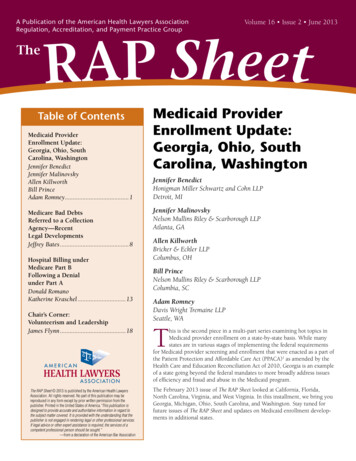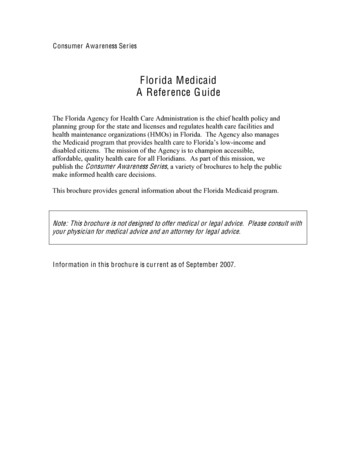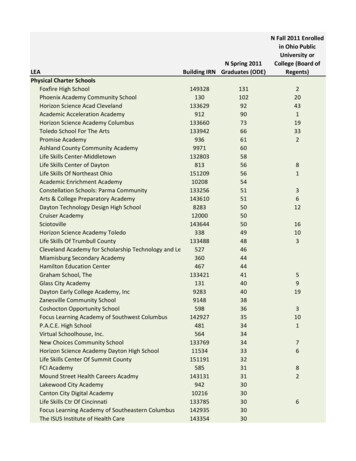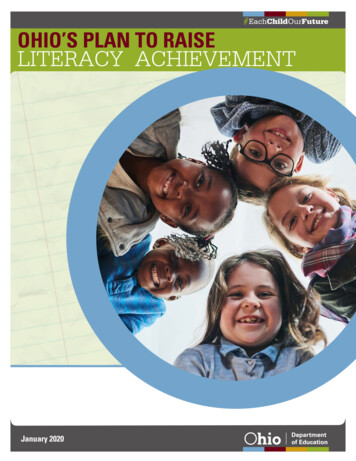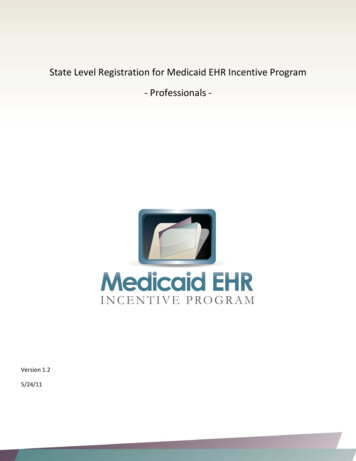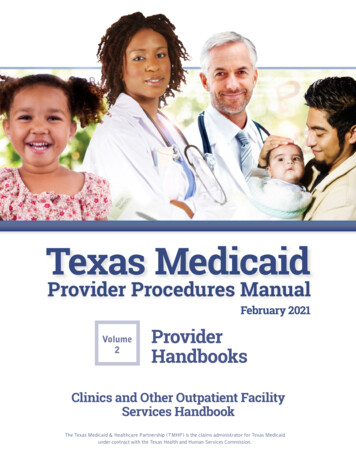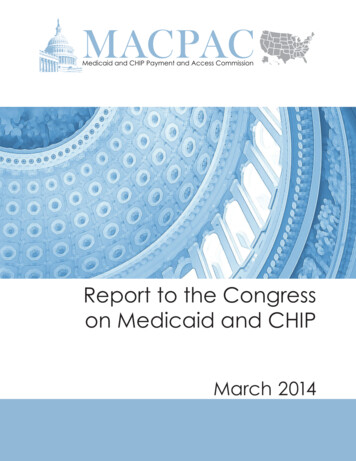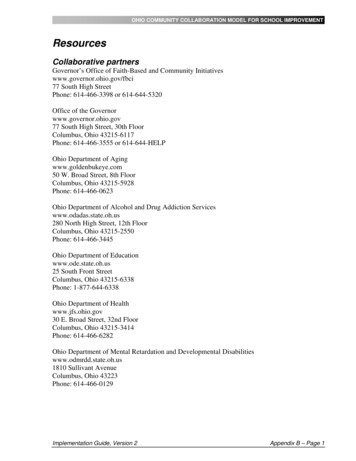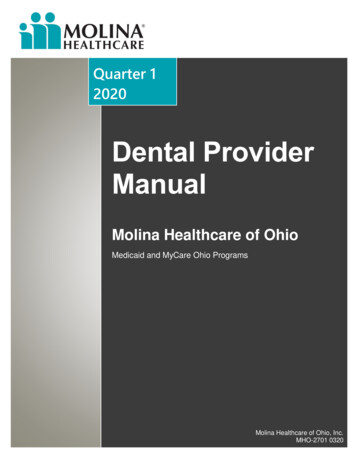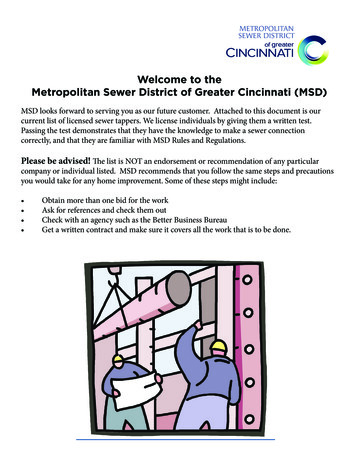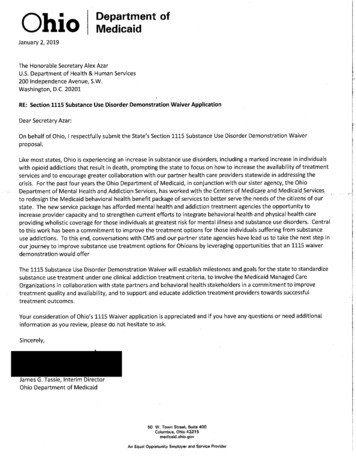
Transcription
OhioDepartment ofMedicaidJanuary 2, 2019The Honorable Secretary Alex AzarU.S. Department of Health & Human Services200 Independence Avenue, S.W.Washington, D.C. 20201RE: Section 1115 Substance Use Disorder Demonstration Waiver ApplicationDear Secretary Azar:On behalf of Ohio, I respectfully submit the State's Section 1115 Substance Use Disorder Demonstration Waiverproposal.Like most states, Ohio is experiencing an increase in substance use disorders, including a marked increase in individualswith opioid addictions that result in death, prompting the state to focus on how to increase the availability of treatmentservices and to encourage greater collaboration with our partner health care providers statewide in addressing thecrisis. For the past four years the Ohio Department of Medicaid, in conjunction with our sister agency, the OhioDepartment of Mental Health and Addictio n Services, has worked with the Centers of Medica.re and Medicaid Servicesto redesign the Medicaid behavioral health benefit package of services to better serve the needs of the citizens of ourstate. The new service package has afforded mental health and addiction treatment agencies the opportunity toincrease provider capacity and to strengthen current efforts to integrate behavioral health and physical health careproviding wholistic coverage for those individuals at greatest risk for mental illness and substance use disorders. Centralto this work has been a commitment to improve the treatment options for those individuals suffering from substanceuse addictions. To this end, conversations with CMS and our partner state agencies have lead us to take the next step inour journey to improve substance use treatment options for Ohioans by leveraging opportunities that an 1115 waiverdemonstration would offerThe 1115 Substance Use Disorder Demonstration Waiver will establish milestones and goals for the state to standardizesubstance use treatment under one clinical addiction treatment criteria, to involve the Medicaid Managed CareOrganizations in collaboration with state partners and behavioral health stakeholders in a commitment to improvetreatment quality and availability, and to support and educate addiction treatment providers towards successfultreatment outcomes.Your consideration of Ohio's 1115 Waiver application is appreciated and if you have any questions or need additionalinformation as you review, please do not hesitate to ask.Sincerely,James G. Tassie, Interim DirectorOhio Department of Medicaid50 W. Town Street, Suite 400Columbus, Ohio·43215medioaid.ohio.govAn Equal Opportunity Employer and Service PtovidefII
Section 1115 DemonstrationWaiver ProposalFor Substance Use DisorderTreatmentSubmitted by theOhio Department of Medicaid1
OHIO MEDICAID 1115 DEMONSTRATION PROPOSAL FOR SUBSTANCE USEDISORDER TREATMENTI. SUMMARYThe Ohio Department of Medicaid (ODM) is requesting an 1115 Demonstration Waiverfor substance use disorder (SUD) inpatient and residential treatment in managed careand fee-for-service (FFS) for adults and children. Ohio also requests this Demonstrationto ensure a complete American Society of Addiction Medicine (ASAM) level of care(LOCs) array is available as part of an essential continuum of care for Medicaid-enrolledindividuals with opioid or other SUDs. This Demonstration waiver is requested to beeffective immediately upon approval to use in Institutions for Mental Diseases (IMDs) asa Medicaid-covered setting.Ohio Medicaid covers all ASAM LOCs 0.5 through 4.0. The Demonstration would permitODM, largely through our contracted Medicaid managed care programs (MCPs), tomaintain critical access to medically-necessary SUD treatment services in the mostappropriate setting for the member, regardless of length of stay, as part of acomprehensive continuum of SUD treatment services. Recent Medicaid managed careregulations impose new limitations on ODM’s use of IMDs as alternative settings forState plan behavioral health (BH) services. In Ohio, these regulations will impedeaccess to inpatient and residential SUD treatment services at a critical time in Ohio’sefforts to implement Medicaid BH reform, and provide SUD treatment to confront Ohio’sopioid epidemic.The Demonstration would also permit ODM, through the FFS program, to providemedically-necessary health care, mental health (MH) and SUD services in the mostappropriate setting for individuals who are not eligible for enrollment in managed care.This will permit Ohio to divert individuals from repeat, costly BH admissions at generalhospitals to more appropriate and cost-effective community-based BH treatment.II. BACKGROUND AND THE IMPACT OF THE MANAGED CARE RULEBackgroundModernizing Ohio Medicaid’s system of delivering BH services has been an ongoingand sequential process beginning with elevation of the funding of the BH benefits to theState level in 2012, and fully integrating the BH benefit package of services into theMCP on July 1, 2018. In keeping with the goal of modernization, from August 2014through the end of 2017, ODM, in collaboration with the Ohio Department of MentalHealth and Addiction Services (OhioMHAS), developed and implemented acomprehensive redesign of the BH benefit package of services provided by communityMH and SUD service providers. The BH Redesign was implemented onJanuary 1, 2018.2
The new benefit service package was divided among five separate State planauthorities, and these State Plan Amendments were approved by the Centers forMedicare & Medicaid Services (CMS) for a January 1, 2018 effective date. Thiscomprehensive restructuring of the BH benefit package of services and the transition ofthe service package to the managed care delivery system created a comprehensive,coordinated system of care for children and adults. Prior to the January 1, 2018implementation date for BH Redesign, Ohio had not adopted a complete array of SUDservices using a national placement criteria (ASAM) or national provider standards, norhad Ohio required providers of BH services to adopt national correct claim coding. Mostimportantly for individuals in need of SUD treatment, there were limited options foroutpatient, community-based SUD services.Outpatient Hospital Behavioral Health was also implemented in August 2017.Previously, some Ohio Medicaid hospital providers separately obtained certificationfrom OhioMHAS and were enrolled in Ohio Medicaid as a Community MH agencyand/or a SUD treatment program in order to provide services in the community underthe former BH benefit package. CMS Medicare provider-based regulations prohibit theestablishment of separate business entities within a 35-mile perimeter of the mainhospital campus. Ohio informed these providers they should relinquish their separateMedicaid enrollment(s) and permitted them to furnish the new BH Redesign serviceswithin their outpatient hospital facilities beginning August 1, 2017. Ohio also opened thenew BH service package to other outpatient hospitals, both to general hospitals and topsychiatric hospitals, who had not previously been able to furnish outpatient services.Essentially, this allowed the outpatient hospitals to provide the new BH service packageon August 1, 2017.The new BH Redesign benefit package introduced new evidence-based practices,such as Assertive Community Treatment (ACT) for adults and promising practices,such as Intensive Home-Based Treatment (IHBT) for children with MH conditions,while also modernizing the SUD treatment benefit to align with the ASAM LOCs foroutpatient and residential treatment. The introduction of ASAM is intended to increasethe use of community-based and non-hospital residential programs, and assured thatinpatient hospitalizations are primarily utilized for situations in which there is a need forsafety, stabilization, or acute detoxification (ASAM LOC 4).The implementation of the new BH benefit package resulted in integrated BH incapitated managed care for adults and children on July 1, 2018. Since July 1, 2018,the MCPs are responsible for providing all health care (including BH services) foradults and children, targeting the goal of improved models of care focused onsupporting individuals in the community and home outside of institutions, increasingoutpatient MH rehabilitation services, introducing a continuum of SUD services alignedwith the ASAM criteria, and deemphasizing the role of hospitals and large institutions(IMDs) in the delivery of covered services. Note: the MyCare Duals Demonstrationplans have been responsible for all BH services, whether furnished by independent3
practitioners in the community or by community BH agencies certified by OhioMHAS,since their inception on May 1, 2014.The Ohio Medicaid MCP currently contracts with five MCPs: Buckeye CommunityHealth Plan (Buckeye), CareSource, Molina Healthcare (Molina), Paramount Advantage(Paramount), and UnitedHealthcare Community Plan (United). For the MyCare Ohioprogram, ODM contracts with four of those plans (excludes Paramount), plus AetnaBetter Health of Ohio (Aetna).Today, Ohio requires most Medicaid/Children’s Health Insurance Program (CHIP)beneficiaries to enroll in capitated managed care. There are a few recipients ( 11%)who receive services under the FFS delivery system. Approximately 89% of OhioMedicaid/CHIP beneficiaries are enrolled in either Ohio Medicaid MCP or MyCare Ohio,a regional MCP for Medicare-Medicaid dual eligibles. This includes 100% ofbeneficiaries in Ohio’s adult expansion (extension adults) who receive the alternativebenefit plan (aligned with the regular State Medicaid plan) and 97% of beneficiaries inOhio’s CHIP program (Healthy Start), which is a Medicaid expansion program.The Impact of the Medicaid Managed Care Final RuleAs stated previously, ODM has designed the current integrated MCP, including SUDservices, with the expectation that Federal Medicaid policy would permit the use ofIMDs as cost-effective alternative services. These settings are a crucial part of Ohio’sSUD treatment provider network in order to maintain critical access to SUD residentialtreatment for Ohio Medicaid enrollees.On May 6, 2016, CMS published new managed care regulations, which permit states touse Federal Medicaid funds for capitation payments to managed care plans for personsreceiving treatment in an IMD “in lieu of” other services covered under the MedicaidState Plan. Under this regulation, Federal payments for IMD services are limited to15 days per month for individuals ages 21-64. In addition, IMD services must bemedically appropriate and cost-effective and enrollees cannot be required to accept IMDservices “in lieu of” other services covered under the Medicaid State Plan.Ohio Medicaid is requesting this Demonstration in order to ensure Federal funding forSUD residential treatment and other health care services for people residing in facilitiesthat meet the IMD definition. Seeking an 1115 Demonstration is the logical next step,following successful redesign implementation and managed care integration to continueto ensure Ohio’s Medicaid beneficiaries have access to the entire continuum of ASAMLOCs. Ohio has a strong foundation for this Demonstration request already in place dueto the redesign and managed care integration completed July 1, 2018.III. DEMONSTRATION OBJECTIVESThe objective of this Demonstration is to maintain critical access to cost-effective SUDtreatment services for Ohio Medicaid enrollees and continue the delivery system4
improvements for these services to provide more coordinated and comprehensive SUDtreatment by Medicaid.This Demonstration seeks to improve outcomes for Medicaid individuals diagnosed withSUDs by maintaining critical access to SUD treatment services, including inpatient andresidential SUD treatment in IMDs, as part of a full continuum of ASAM LOCs alignedtreatment services. Under BH Redesign, Ohio designed a comprehensive, integratedBH benefit that includes cost-effective alternatives to State Plan residential treatmentsettings by IMDs. However, recent changes to Medicaid managed care regulations andexisting IMD limitations in FFS create barriers to ensuring individuals are able to accessSUD treatment at a LOC appropriate to their needs using the ASAM criteria. ThisDemonstration seeks authority so Federal Medicaid managed care restrictions on IMDsas SUD treatment settings do not disrupt the Medicaid SUD treatment continuum inOhio by inadvertently reducing critical access to SUD treatment recently expandedthrough BH Redesign.Implementing the limitations of the Medicaid managed care final rule has the potential tohinder Ohio’s progress with BH reform by reducing access to community-basedresidential treatment services, creating a critical access problem in the State for SUDtreatment services, and increasing costs to the State and Federal governments. Theremay not be enough SUD residential treatment programs in Ohio with 16 or fewertreatment beds to address the extent of the opioid epidemic in the State. This isparticularly true since the State expanded Medicaid eligibility (effective January 2014)and such services are available to more than 700,000 Expansion-eligible individuals.Restricting Medicaid funding at this juncture would cripple the State’s ability to addressthe surge of SUD treatment needs for Medicaid enrollees.The Demonstration will also remove Medicaid payment barriers in FFS for SUDresidential treatment for individuals in need of these services. By preserving criticalaccess to residential treatment capacity, Ohio will be able to continue to provide aneffective SUD treatment continuum of care with interventions capable of meetingindividuals’ changing needs for various ASAM LOCs. As individuals move throughoutthe continuum in their SUD recovery, they may need to transition to LOCs of greater orlesser intensity.IV. Comprehensive Description of Strategies for Addressing Goals andMilestonesThe State’s initial approach to key system reform milestones will be addressed in thecomprehensive Implementation Plan submitted concurrently with this Demonstrationrequest. The Implementation Plan addresses system reforms required in the 2017 StateMedicaid Director’s Letter and outlines a path toward an IMD exception using the 1115Demonstration authority. A brief summary of the State’s current environment for eachmilestone is listed below.5
Milestone 1: Access to Critical LOCs for Opioid Use Disorder (OUD) and OtherSUDsOhio’s OUD and SUD treatment systems includes early intervention, coverage ofoutpatient, intensive outpatient and partial hospitalization services, MAT (medications,as well as counseling and other services with sufficient provider capacity to meet needsof Medicaid beneficiaries in the State), intensive LOCs in residential and inpatientsettings, and medically supervised withdrawal management.The State ensures sufficient coverage by contractually requiring the MCPs todemonstrate network adequacy for services. If services are unavailable within thespecific region, the MCP is required to contract for services with providers outside thedefined geographical boundaries.Milestone 2: Use of ASAM Placement CriteriaThe State requires all SUD treatment providers to assess and provide services usingthe ASAM criteria. ODM requires SUD treatment providers enrolled in Medicaid to usemulti-dimensional assessments based on the six dimensions of care as outlined inASAM. In addition, for providers who must be certified by OhioMHAS, the ASAM criteriais required as a condition of certification.Ohio Administrative Code (OAC) rule 5160-27-09 describes SUD treatment servicesprovided to Medicaid recipients regardless of delivery system. This regulation requiresthe use of the ASAM treatment criteria for addictive, substance related, andco-occurring conditions for admission, continued stay, discharge, or referral to eachLOC.The current ODM MCP provider agreement requires all plans to follow the priorauthorization standards established under BH Redesign for both the FFS and managedcare delivery systems. On and after July 1, 2019, SUD services provided in themanaged care and FFS delivery systems will comply with the ASAM criteria for all priorauthorization and utilization review decisions resulting in continued continuity across theMedicaid delivery systems. The MCP provider agreement will be updated to emphasizethe required use of the ASAM criteria for all SUD services regardless of site, providertype, or LOC. MCPs prior authorize SUD residential treatment services for theirmembers while SUD residential treatment for individuals enrolled in the FFS deliverysystem is prior authorized by ODM or its designee. This will ensure members haveaccess to SUD treatment at the appropriate LOC and interventions are appropriate foreach person’s diagnosis and LOC.Milestone 3: Use of ASAM Program Standards for Residential ProviderQualificationsODM and OhioMHAS require Medicaid participating providers of SUD treatmentservices to use the ASAM criteria. These requirements apply to SUD residentialtreatment service providers under both the managed care and FFS delivery systems.OhioMHAS’ certification regulation in OAC rule 5122-29-09 require residential,6
withdrawal management, and inpatient SUD treatment services to be provided inaccordance with the ASAM LOC 3. ODM’s rule, 5160-27-09, also requires residentialservices/inpatient services to be provided in accordance with ASAM LOC 3. ASAM’sLOC 3 and associated sub levels are to be provided as appropriate to the needs of theindividual being served and as published in The ASAM Criteria, Third Edition, 2013 .In the future, Medicaid policy manuals will be modified to include more detail about theASAM residential program requirements including the particular types of practitionerservices, hours of clinical care, and credentials of staff for residential treatment. This willinclude a requirement that residential treatment providers offer MAT on-site or facilitateaccess off-site with a MAT provider not associated with the residential treatment owner.Medicaid will also implement a process for reviewing residential treatment providers toensure compliance with these requirements and for IMD determination.Milestone 4: Provider Capacity of SUD Treatment including MATAs part of preparing for the inclusion of BH Redesign benefit package in MCP contractson July 1, 2018, ODM conducted readiness reviews of the MCPs to ensure the panelstandards required of plans were met. This included ensuring each MCP had at least aminimum number of comprehensive Alcohol and Drug treatment providers in eachregion. If a covered Medicaid service is not available in network, the MCP must arrangefor that service to be provided out-of-network at no additional charge to the member.Ohio has 4,135 SUD residential treatment beds across 178 OhioMHAS-certified SUDresidential, withdrawal management, and inpatient SUD service programs that mightmeet the definition of an IMD.The estimated number of residential days for each residential LOC based on 2014 datawas estimated to be:ST ATE FISCALYEAR 2014ASAM 3.1ADULTDAYSCHILDDAYSTOTALEST IM AT ED DAYS00037135406ASAM 3.3 (adults only)22,061N/A22,061ASAM 3.570,75939,171109,930ASAM 3.75,4041,8687,272ASAM 3.7 179ASAM 3.2 WithdrawalManagementTotalThe State expects to be able to develop an assessment of the availability of theproviders enrolled in Medicaid and the ability to accept new patients in each of the SUD7
residential LOCs within 12 months of Demonstration approval. This assessment willindicate whether facilities accept clients funded through managed care by plan, FFS, orboth delivery systems.Milestone 5: Implementation of OUD Comprehensive Treatment and PreventionStrategiesOpioid Prescribing Guidelines and Other Interventions to Prevent Opioid AbuseTo address the opioid crisis (which is discussed in the next major section below), Ohiohas implemented five sets of prescribing guidelines to prevent opioid abuse. Prescribingguidelines addressed the easiest sources of uncoordinated prescription medicationsthrough the emergency departments. Tighter guidelines for patients requiring thehighest doses of prescription opioids addressed issues for those already taking opioidmedications. Additional interventions included:1. Closing “pill mills” in 2012.2. Eliminating the possibility of calling in Schedule II drugs such as hydrocodone(Vicodin ).3. Reducing the number of patients starting their first opioid.4. Requiring Medicaid MCPs to put edits in place within their pharmacy programsto support prescribing guidelines.5. Requiring MCPs to implement Medication Therapy Management for those withproblematic polypharmacy and a Coordinated Services Program to provide caremanagement services for members who overuse or misuse services.Over the course of the development of these guidelines and rules, the State of Ohiowas able to achieve a 28% reduction in solid doses of opioids prescribed from196 million doses per quarter in Q2 2013 to 136 million in Q2 2017. 1 For acute pain,prescriptions fell from 70 million per quarter to 51 million over that same time frame witha reduction in number of patients with any opioid falling from 1.29 million per quarter to948,000 per quarter.These initiatives have resulted in direct impacts on Medicaid prescribing. The Medicaidopioid claims have reached a low of 116,348 claims in December 2017.1OARRS data, Ohio’s Opioid Epidemic, The Medicaid Experience & Progress to Date, Agency Briefing onOpioids October 2017 SPA-5, Mary Applegate, MD, FAAP, FACP, Slide 33.8
Ohio is one of the first states to realize a reduction in opioid deaths related toprescription drugs in the midst of escalating overall deaths driven by illicit drug use. Ofall unintentional drug overdose deaths, the percentage of prescription opioid-relateddeaths in Ohio declined for a fifth straight year in 2016, and the number of these deathsdeclined 15.4% from 667 in 2015 to 564 in 2016 — the fewest since 2009. 2Expanded Coverage of, and Access to, Naloxone for Overdose ReversalOhio has taken steps to prevent drug overdose deaths through the expanded availabilityand use of the opiate overdose reversal drug Naloxone. One of the most effective stepsfor expanding coverage included permitting pharmacists to dispense Naloxone without aprescription in 2015. To assist pharmacies, the State of Ohio Board of Pharmacydeveloped a dedicated web page, www.pharmacy.ohio.gov/naloxone, which featureshelpful resources including a guidance document, sample protocol, and a listing of allparticipating pharmacies. The Pharmacy Board also offers printed, no-cost patienteducational materials to any participating pharmacy. By 2017, more than 1,600 Ohiopharmacies in 87 counties offer Naloxone without a prescription.Additionally, as part of an early adoption of components of the BH Redesign project,beginning January 1, 2017, Ohio’s opioid treatment programs are now able toadminister and dispense Naloxone and their physicians to personally furnish Naloxonein accordance with the State of Ohio Board of Pharmacy requirements.Increasing Utilization and Improving Functionality of Prescription DrugMonitoring ProgramsOhio first mandated use of the Ohio Automated Reporting Rx System (OARRS), theState’s prescription drug monitoring program by prescribers in 2011, with additionalprovisions added in 2013. OARRS is a tool to track the dispensing and personalfurnishing of controlled prescription drugs to patients. OARRS is designed to monitorthis information for suspected abuse or diversion (i.e., channeling drugs into illegal use),and can give a prescriber or pharmacist critical information regarding a patient’scontrolled substance prescription history. This information can help prescribers andpharmacists identify high-risk patients who would benefit from early interventions.2Mortality data can be found at the following wser/Browse/Mortality9
Since the latest mandate in 2013, the use of the OARRS system has grown. In 2017,the OARRS reported a record high of 265,242 requests by prescribers and pharmacistsin a single day. By comparison, the single day high in 2016 was 86,129 prescriber andpharmacist requests. In August 2018, OARRS reported an average of more than599,000 requests per weekday – more than double the previous year’s high.OARRS has also documented that fewer Ohioans are using multiple prescribers orpharmacies (i.e., doctor shopping). In 2017, data from OARRS found the number ofindividuals using more than five prescribers for prescription opiates has decreased 88%since 2011. 3 Similarly, the number of Medicaid members with four or more pharmacieshas continuously dropped since January 2017.The State of Ohio plans to leverage opportunities described in SMD Letter 16-003 tohelp professionals and hospitals eligible for Medicaid Electronic Health Record (EHR)Incentive Payments connect to other Medicaid providers through the integration ofOARRS into electronic medical records and pharmacy dispensing systems. All hospitalsand pharmacies now have the ability to have OARRS integrated into their EHRs andPharmacy management systems. Nearly half of physicians now have integrated accessto OARRS. 4 This initiative will allow the State to meet the following objectives: Further reduce the number of individuals who doctor shop.Provide health care providers critical information regarding a patient’s controlledsubstance prescription history and expand collection of other data sources tosupport clinical decision-making.Support clinician interventions for patients exhibiting high-risk behaviors.3Ohio Board of Pharmacy. 20(2017)%20%20Executive%20Summary.pdf4Ohio Board of Pharmacy. 20(2017)%20%20Executive%20Summary.pdf10
Assist providers in achieving the medication reconciliation meaningful useobjective and measure. 5An additional goal of this integration initiative is to provide as many avenues as possiblefor an authorized health care provider to access Ohio’s Prescription Drug MonitoringProgram, including integrated access through Health Information Exchanges (HIEs). Infact, Ohio’s two largest HIEs, CliniSync and The Health Collaborative (HealthBridge),have already been integrated with OARRS under this initiative.Milestone 6: Improved Care Coordination and Transition between LOCsOhio has multiple interventions for coordinating the care of individuals with SUD andtransitioning between LOCs, including but not limited to, targeted case management,facility discharge requirements, care coordination in MCP contracts, and the proposedBH Care Coordination Program, also implemented in the managed care deliverysystem.V. Comprehensive Plan to Address Opioid Abuse and Assessment of How theDemonstration Complements and Does Not Supplant Other State ActivitiesThe Governor’s Cabinet Opiate Action Team (GCOAT) comprises all cabinet-levelagencies and is charged with the coordination of all activities addressing Ohio’sescalating opioid crisis. This Demonstration is being coordinated with that larger effortand will complement and not supplant State activities called for or supported by otherFederal authorities and funding streams.Over the last several years, ODM has played a crucial role in the GCOAT. GCOAT’sinterventions increased as opioids deaths rose from 1,914 in 2012 to 4,050 in 2016. 6See Figure 1 for maps outlining the growth in drug-related deaths in Ohio countiesbetween calendar year (CY) 2012 and CY 2017.5Stage 3 of Meaningful use consolidates Medication reconciliation into the Health Information ExchangeObjective. The objective requires the Eligible Professional provides a summary of the care record whentransitioning or referring their patient to another setting of care, receives or retrieves a summary of carerecord upon the receipt of a transition or referral or upon the first patient encounter with a new patient,and incorporates summary of care information from other providers into their EHR using the functions ofCEHRT. Providers must attest to all three measures and must meet the threshold for at least twomeasures to meet the objective.6Mortality data can be found at the following wser/Browse/Mortality11
Figure 1: Map of the rate of Drug-Related Overdose Deaths per 100,000 people in Ohio counties in2017 7.Number of Unintentional Opioid-Related Overdose DeathsCY 2017CY 2012QuintileODM has been particularly assertive in this work as the Centers for Disease Control andPrevention (CDC) reported Medicaid members were prescribed opioids at more thantwice the rate as those with commercial insurance and were at greater risk for opioidabuse and death. 8ODM efforts have primarily focused on the five prongs of the Health and HumanServices (HHS) Opioid Strategy (see Figure 2 for a visual of the HHS Opioid strategy)including:1. Improving access to prevention, treatment, and recovery support services.2. Targeting distribution of overdose-reversing drugs.3. Advancing the practice of pain management.7“Governor’s Cabinet Opiate Action Team Dashboard” (slide 9)CDC. Overdose deaths involving prescription opioids among Medicaid enrollees. Morbidity and MortalityWeekly Report. 2009; 58:1171-1175, and CDC. Patient review and restriction programs: Lessons learnedfrom state Medicaid programs. CDC Expert Panel Meeting Report. Aug 27-28, 2012; Atlanta, GA).812
4. Supporting cutting-edge research.5. Strengthening timely public health data and reporting.Figure 2: HHS Opioid strategyImprovingaccess toprevention,treatment, andrecoverysupport servicesAdvancing thepractice of ingavailability anddistribution ofoverdosereversing drugsStrengtheningtimely publichealth dataand reportingVI. DELIVERY SYSTEMThis Demonstration will not change the
increase provider capacity and to strengthen current efforts to integrate behavioral health and physical health care . (Molina), Paramount Advantage (Paramount), and UnitedHealthcare Community Plan (United). For the MyCare Ohio program, ODM contracts with four of those plans (excludes Param
